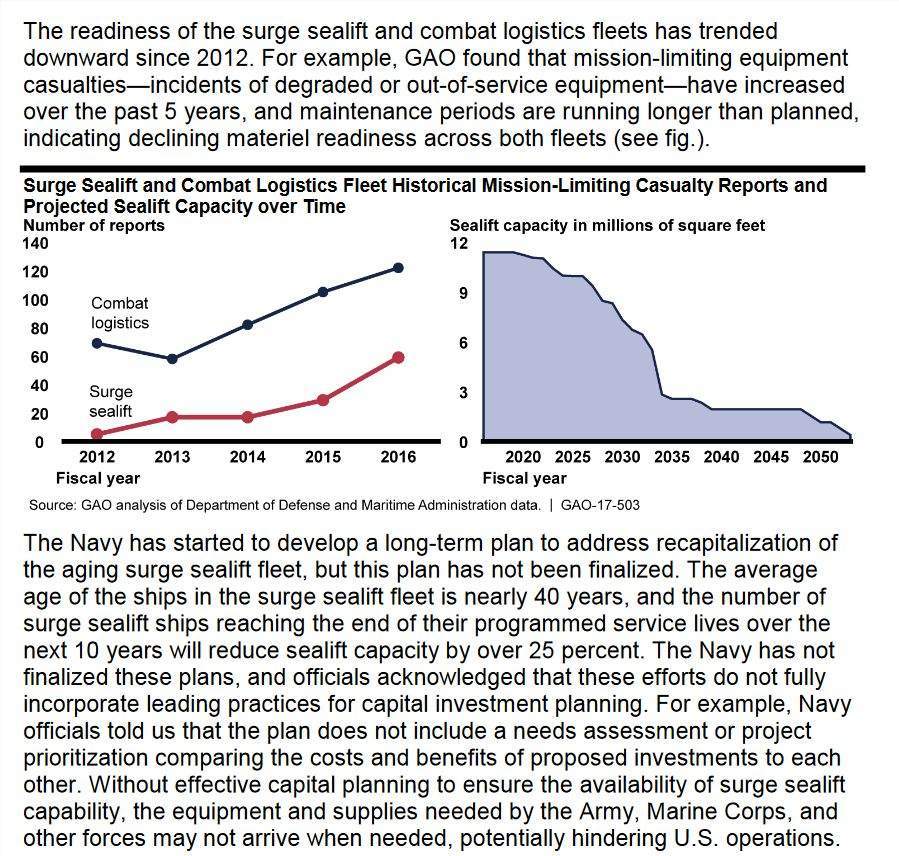Jura The idiot
General
Oct 30, 2018
Study Says Navy Logistics Fleet Would Fall Short in High-End Fight
nowI'll rephrase Yesterday at 8:24 AM post;
there're indications (I've posted these links and the chart before) of the auxiliary fleet FALLING APART:

...
Study Says Navy Logistics Fleet Would Fall Short in High-End Fight
... goes on below due to size limitThe Navy is struggling to find support to buy new logistics ships, even as a new study finds the Navy’s current plans to recapitalize that logistics fleet are insufficient to support distributed operations in a high-end fight against China or Russia.
A new study by the Center for Strategic and Budgetary Assessments finds that the Navy needs to spend $47.8 billion over the next 30 years beyond what it has currently laid into its plans in order to build a logistics fleet that could refuel and resupply the Navy and Marine Corps in a fight. The study notes that, while the Navy’s current plans could support the fleet into the future in a peacetime environment, the Navy may need nearly 100 additional logistics ships of various types if it wants to win a fight against China in particular.
Today’s “logistics system is optimized for the sorts of operations that we have been having over the past 20 or so years, and it has become very efficient. However, if we … look towards moving towards great power competition with China or Russia as the adversary, who could project threats to that logistics force further back in the chain, the way we think about this problem changes dramatically,” Harrison Schramm, a co-author of the “” study, said at an event today.
“The Navy currently has a hub-and-spoke model that’s highly efficient, but it’s subject to adversary interdiction of those forward bases. Additionally, because it’s been so efficient, the Navy has reduced its stocks of onboard spares aboard ships and to some degree eliminated intermediate-level maintenance of aircraft aboard carriers and other ships. It’s been an efficient model that saves funds, but it’s unsuitable for conflict against China or Russia,” co-author Tim Walton .
Navy Secretary Richard V. Spencer spoke at the event and called logistics “an absolutely critical issue” for the Navy today, but he also noted the difficulty in making a business case for it. The Navy is currently working off a three-pronged plan from Congress: extending the service lives of some logistics and support ships, buying used ships to replace some of the very oldest ones, and then building some new ships under the . Though Naval Sea Systems Command is moving out on industry engagement to inform the CHAMP program, Spencer’s comments reflect an uncertain future for the shipbuilding program despite the or sooner.
“Putting my business hat on for the business case, I can’t afford a lot of $600-million ships. I can’t really afford a lot of $400-million ships, when I can go out and buy used [roll-on/roll-off ships] for $35 to $40 million. I’m up on the Hill asking to get a little more relief – I said, I don’t want to abandon shipbuilding, please don’t get me wrong, but I need a quick little shot in the arm on the ability to rebuff and rebuild … my ability to deliver on the high seas,” Spencer said at the CSBA event today.
He did not take questions from the audience or press and did not follow up on what balance of new shipbuilding versus buying used he is advocating to lawmakers. Throughout his remarks, though, Spencer noted the tension between getting more ships for the dollar buying used versus the industrial base benefits and the long-term usage of building new ships.
“I am responsible for keeping the health of an industry; that certainly doesn’t mean my checkbook is wide open indiscriminately. We have to make every dollar count, and we have to work on this situation,” he said.
“I totally get it, buying a used ship does not promote shipbuilding community. I need to balance new and the ability to have the [total fleet support] requirement fulfilled.”
Spencer said he was on Capitol Hill this week and that logistics came up in two of his seven office visits. While speaking with one senator who was particularly interested in recapitalizing the logistics fleet, “the first point she said is, ‘but you are not funded for it, Mr. Secretary.’ And I said, ‘you’re exactly right, Senator, and we have to get after this.’”
The secretary said the Navy has not properly funded its fleet logistics and sealift ships in the past because they fall lower on the list of priorities, but he said the Navy needs to do better now and that he hoped the CSBA study would have a forcing function to make the Navy and lawmakers figure out a good path forward.
...
